Industrial NOR Flash Market Size and Share
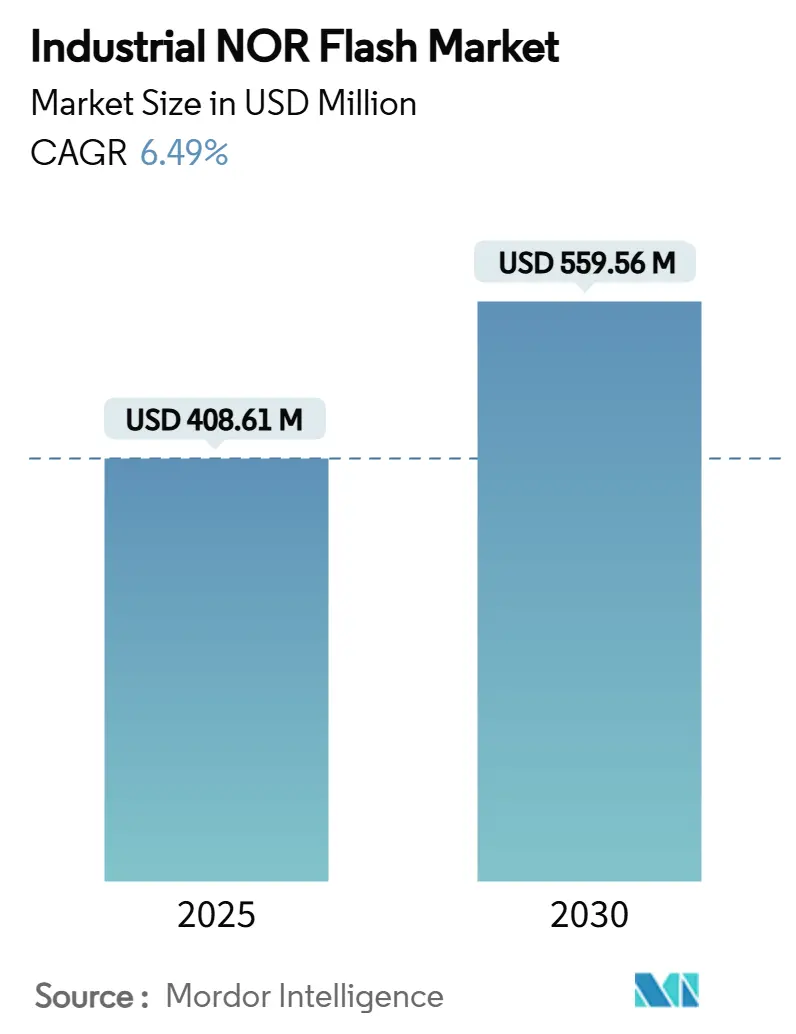
Industrial NOR Flash Market Analysis by Mordor Intelligence
The Industrial NOR flash market size stands at USD 408.61 million in 2025 and is forecast to reach USD 559.56 million in 2030, expanding at a 6.49% CAGR. Growth stems from industrial customers favoring reliable, fast-boot non-volatile memory for secure-boot chains, over-the-air (OTA) updates, and long-life operation. Heightened cybersecurity regulations, rising edge-AI workloads, and mission-critical adoption in aerospace, power grids, and transportation continue to pull demand toward higher-speed, higher-capacity devices. Interface innovation—especially Quad, Octal, and xSPI protocols drives system-level performance gains that outweigh raw density considerations. Meanwhile, capacity expansions in China, post-quantum cryptography (PQC) integration, and the migration to sub-28 nm nodes reshape the competitive field.
Key Report Takeaways
- By type, Serial NOR commanded 87.2% revenue share in 2024, while Parallel NOR declined; Serial NOR is projected to post a 6.5% CAGR through 2030.
- By interface, Quad SPI held 45.1% of the Industrial NOR Flash market share in 2024; Octal/xSPI is the fastest-growing interface segment at a 6.7% CAGR to 2030.
- By density, greater than 256 Mb devices led growth with 6.6% CAGR; the 32–64 Mb tier remained the largest, holding 21.4% of the Industrial NOR Flash market size in 2024.
- By voltage, the 1.8 V class retained 39.2% share in 2024; Sub-1.8 V parts are advancing at 6.6% CAGR on the back of battery-powered industrial IoT adoption.
- By process node, 55 nm devices held a 31.5% share in 2024; 28 nm and below nodes are forecast to expand at a 6.8% CAGR.
- By packaging type, QFN / SOIC held a 36.2% share in 2024; WLCSP / CSP are forecast to expand at a 6.5% CAGR.
- By geography, Asia-Pacific dominated with over 50% market share in 2024; it is also the fastest-growing region at a 7.4% CAGR to 2030.
- The top five suppliers, including Winbond, Macronix, GigaDevice, Infineon (Cypress), and Micron, controlled more than 55% of 2024 revenue.
Global Industrial NOR Flash Market Trends and Insights
Drivers Impact Analysis
| Driver | (~) % Impact on CAGR Forecast | Geographic Relevance | Impact Timeline |
|---|---|---|---|
| Quad/Octal SPI adoption for fast-boot IoT edge devices | +1.8% | Asia-Pacific, North America | Medium term (2-4 years) |
| Constellation-scale LEO satellites requiring rad-hard NOR | +1.2% | North America, Europe, China | Long term (≥ 4 years) |
| China’s 55/40 nm process push for NOR self-sufficiency | +1.5% | China, Southeast Asia | Medium term (2-4 years) |
| Secure-boot and OTA mandates in Industry 4.0 factories | +1.6% | Europe, North America, Japan, South Korea | Short term (≤ 2 years) |
| Low-power 1.8 V serial NOR for wearable/PoC healthcare | +0.9% | Global (early in North America, Europe) | Medium term (2-4 years) |
| Source: Mordor Intelligence | |||
Quad/Octal SPI adoption accelerates edge computing capabilities
Upgrading from Quad to Octal SPI cuts boot times sixfold, an advantage that keeps assembly-line robots, factory gateways, and programmable controllers online after power dips. GigaDevice’s GD25LX series reaches 400 MB/s data throughput, trimming firmware download from 480 ms to 80 ms [1]GigaDevice. "GigaDevice: An Innovator of Memory Designs Brings in High ..." Accessed April 17, 2025. . Edge-AI devices now give memory-interface bandwidth the same weight as processor speed. Automotive plants using Octal-SPI NOR recover in milliseconds, raising overall equipment effectiveness without redesigning full boards.
Radiation-hardened NOR Flash enables the new space economy
LEO constellations introduce thousands of satellites that each embed several radiation-tolerant NOR parts. Infineon debuted a 512 Mbit rad-hard QSPI device running 133 MHz that withstands single-event effects[2]Infineon Technologies. "Satellite 2025 – Driving Business: Inspiring Purpose." Microwave Journal, March 24, 2025.. Commercial off-the-shelf-plus qualification blends lower cost with aerospace reliability, making NOR Flash a pivotal enabler for space-borne firmware, telemetry logs, and secure command stores.
China’s indigenous NOR ecosystem reshapes supply chains
Beijing’s investment fund backs 55 nm and 40 nm lines, propelling GigaDevice’s fivefold 2024 profit jump and lifting local sourcing among European industrial OEMs seeking multisourcing security. Domestic capacity tempers global price spikes and encourages non-Chinese vendors to sharpen differentiation on endurance and integrated security rather than node leadership alone.
Secure-boot mandates drive advanced authentication requirements
Industrial regulators now require cryptographically authenticated boot paths and tamper-proof OTA updates. Winbond’s W77Q family integrates asymmetric keys, Common Criteria EAL 2+ certification, and PQC preparedness [3]Winbond. "W77Q Secure Flash Memory (CC EAL 2+) - TrustME ®." Accessed April 17, 2025. . European grid operators have standardized such secure NOR Flash in substation controllers, blocking unauthorized firmware while slashing reliance on external security ICs.
Restraints Impact Analysis
| Restraint | (~) % Impact on CAGR Forecast | Geographic Relevance | Impact Timeline |
|---|---|---|---|
| Cost premium over NAND above 256 Mb | -0.7% | Global (price-sensitive markets) | Medium term (2-4 years) |
| Scaling ceilings beyond 45 nm steering OEMs toward MRAM/RRAM | -0.9% | North America, Europe, Japan | Long term (≥ 4 years) |
| Foundry concentration in Taiwan exposing supply-chain risk | -0.6% | Global (highest in North America, Europe) | Medium term (2-4 years) |
| ASP compression from expanding Chinese capacity | -1.1% | Global (strongest on non-Chinese vendors) | Short term (≤ 2 years) |
| Source: Mordor Intelligence | |||
Physical scaling limitations drive alternative memory exploration
Below 45 nm, NOR cells struggle with dielectric thickness and channel control, pushing FPGA and PLC designers toward MRAM and RRAM that promise unlimited endurance and higher write bandwidth[4]Everspin Technologies, Inc. "Form 10-K for Everspin Technologies INC filed 02/27/2025." December 31, 2024. . TSMC already mass-produces RRAM at 40 nm and eyes 22 nm nodes. Industrial buyers are trialing MRAM in high-end controllers to cut write energy and extend lifetime, although higher die cost slows wide adoption.
Chinese capacity expansion drives margin compression
Government-backed fabs have flooded the 55 nm segment, triggering price swings that squeeze incumbents. European automation firms now lock multi-vendor supply at favorable pricing, using oversupply to hedge against disruptions. Established suppliers counter by embedding high-speed encryption engines and automotive -40 °C to +125 °C grade assurances, carving niches less vulnerable to commodity cycles.
Segment Analysis
By Type: Serial NOR dominance sustains interface migration
Serial parts captured 87.2% of the Industrial NOR flash market share in 2024. The consolidation reflects two-wire pin savings, low power profiles, and controller ubiquity that suit compact industrial IoT nodes. Parallel NOR endures in high-bandwidth boot ROM for legacy boards but cedes sockets as Octal SPI overturns the bandwidth gap.
Serial’s 6.5% CAGR (2025-2030) keeps pace with code base growth as suppliers roll out 1.2 V, 120 MHz devices that fit AI-assisted cobots and predictive-maintenance sensors. Manufacturers gain board-space relief and higher EMI resilience while holding firmware in non-multiplexed memory, a proven reliability measure for long-life equipment.
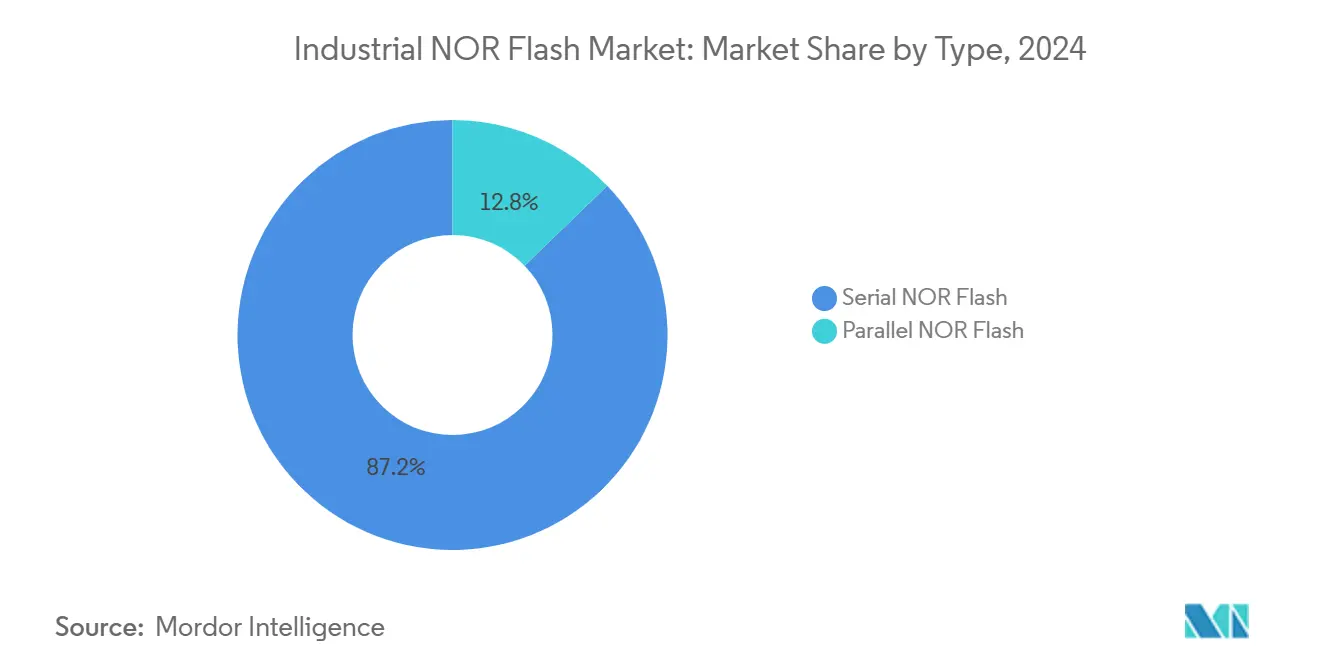
By Interface: Octal and xSPI unlock next-generation throughput
Quad SPI held 45.1% in 2024 and remains the workhorse for PLCs, HMIs, and industrial drives. Yet the Industrial NOR Flash market already pivots toward Octal/xSPI, forecast at a 6.7% CAGR to 2030, as boot durations fall by 70% in controller upgrades.
xSPI’s JESD251C standard secures cross-vendor interoperability, letting OEMs pair NOR Flash with any MCU or ASSP that carries an xSPI host. Adoption accelerates where secure-boot hash checks run in place and demand continuous fetch bandwidth. Single and Dual SPI now serve the lowest-cost gear but will continue to lose share as interface premiums narrow.
By Density: High-capacity tiers underpin secure-update architectures
The 32–64 Mb band represents 21.4% of 2024 revenue, matching typical firmware footprints for PLCs, gateway routers, and motor drives. However, larger, security-heavy images lift the greater than 256 Mb tier to a 6.6% CAGR. Each over-the-air update retains a rollback copy, doubling required code space, while AI inference modules at the edge justify further growth.
Lower densities (≤8 Mb) retreat to simple sensors, whereas mid-range 128 Mb devices keep steady traction for vision inspection units upgrading to neural algorithms. The Industrial NOR Flash market size for high-capacity devices is set to expand fastest as designers future-proof flash footprints.
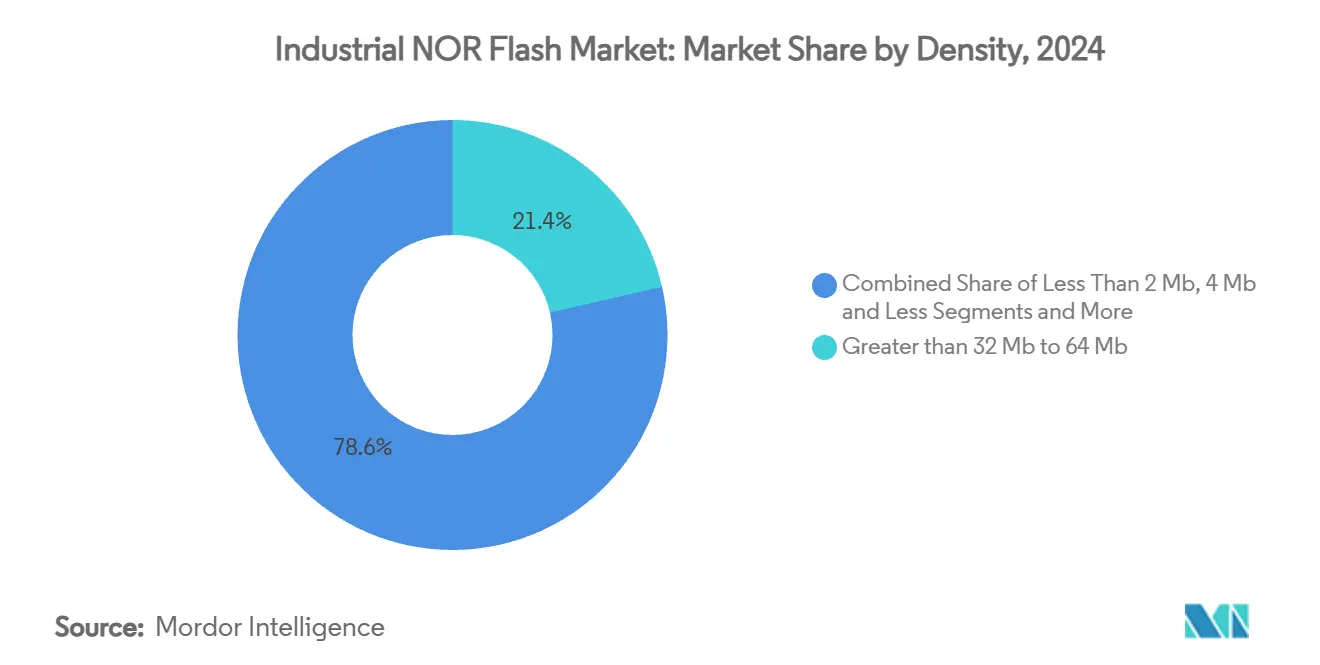
Note: Segment shares of all individual segments available upon report purchase
By Voltage: 1.8 V class anchors energy-efficient platforms
Low-power industrial edge nodes standardize on 1.8 V flash for compatibility with advanced 28 nm MCUs. This class controlled 39.2% of 2024 shipments. Wide-voltage 1.65–3.6 V variants bridge mixed-voltage backplanes, sustaining replacement business in brownfield factories.
Sub-1.8 V parts, projected at 6.6% CAGR, trim read current by up to 50%. GigaDevice’s dual-supply 1.2 V solution halves read power consumption for solar-powered crop-monitoring sensors. Noise-margin challenges in high-EMI plants are met with on-die filtering enhancements.
By Process Technology Node: 55 nm remains mainstream; sub-28 nm scales up
At 31.5% share, 55 nm balances cost, reliability data, and capacity yield. Legacy 65 nm and older continue in power-hungry drives, requiring proven field data. Yet 28 nm and finer geometries post a 6.8% CAGR as Macronix samples 45 nm devices and tests 4 Gb 3D NOR mxic.com.tw. Faster boot and lower standby current appeal to high-end controllers with AI coprocessors.
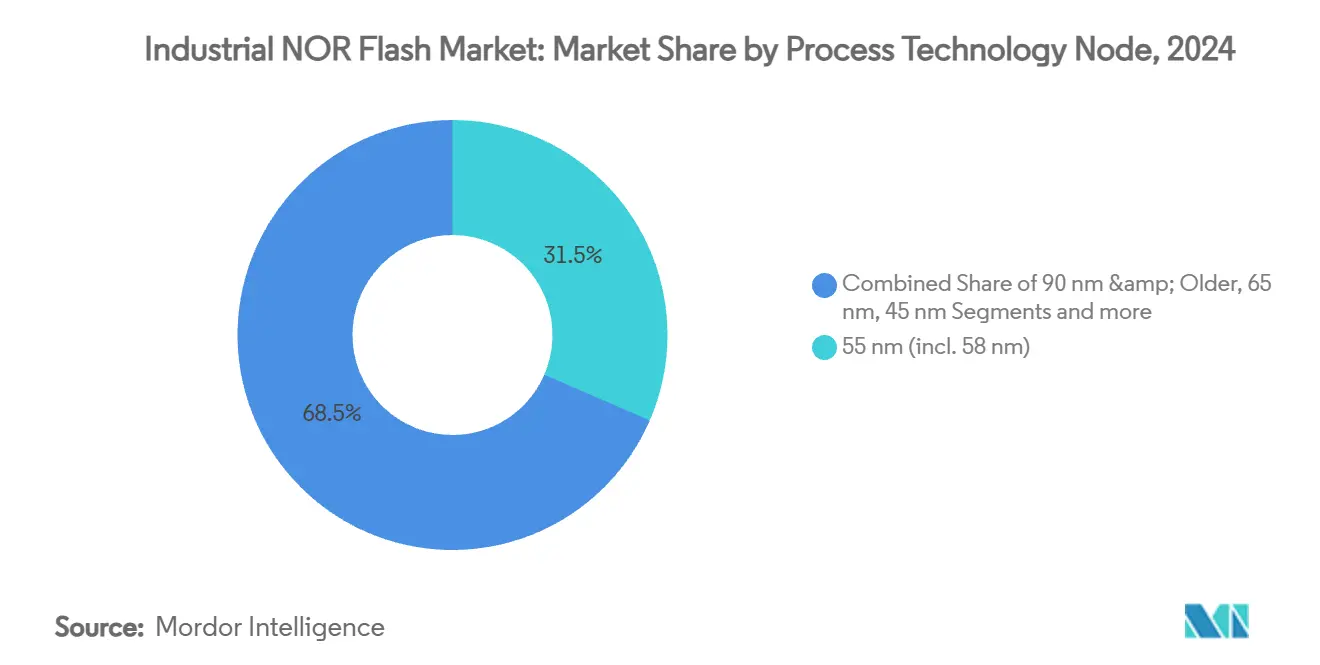
Note: Segment shares of all individual segments available upon report purchase
By Packaging Type: QFN/SOIC deliver rugged reliability
QFN/SOIC packages led with a 36.2% share in 2024, valued for their moisture resistance and simplified visual inspection. BGA/FBGA tackles space-constrained boards running 166 MHz buses.
WLCSP/CSP, growing at 6.5% CAGR, shrinks footprints for industrial drones and wearable diagnostic instruments. The S29VS064RABBHI010 64-ball FBGA illustrates tight form-factor integration for mid-density flash. OEMs now choose identical dies across multiple packages to streamline firmware qualification, yet serve diverse board layouts.
Geography Analysis
Asia-Pacific commanded over 50% of the Industrial NOR flash market in 2024 and will advance at a 7.4% CAGR, driven by vertically integrated electronics clusters in China, Taiwan, South Korea, and Japan. China’s self-reliance agenda funds indigenous 55 nm fabs, while Taiwan hosts the lion’s share of advanced foundry capacity. Japanese and South Korean suppliers contribute automotive-grade, high-reliability devices, reinforcing the region’s leadership in stringent industrial specifications.
North America follows, anchored by aerospace, defense, and critical-infrastructure programs that specify tamper-resistant, radiation-hardened memory. The CHIPS and Science Act earmarks USD 50 billion in grants to revive domestic fabs producing NOR nodes required for satellite and avionics platforms. Local OEMs value verified supply chains and have prioritized secure-boot capable products, stabilizing demand despite periodic price swings.
Europe’s share rests on its robust industrial automation base and early Industry 4.0 adoption. EU cybersecurity mandates spur uptake of secure NOR with embedded encryption, while the European Chips Act targets 20% of global semiconductor production by 2030. Emerging economies across South America, Africa, and South Asia represent smaller yet rising demand streams as they digitize utilities and rail networks, often favoring mature, wide-voltage flash that ensures field repairability.
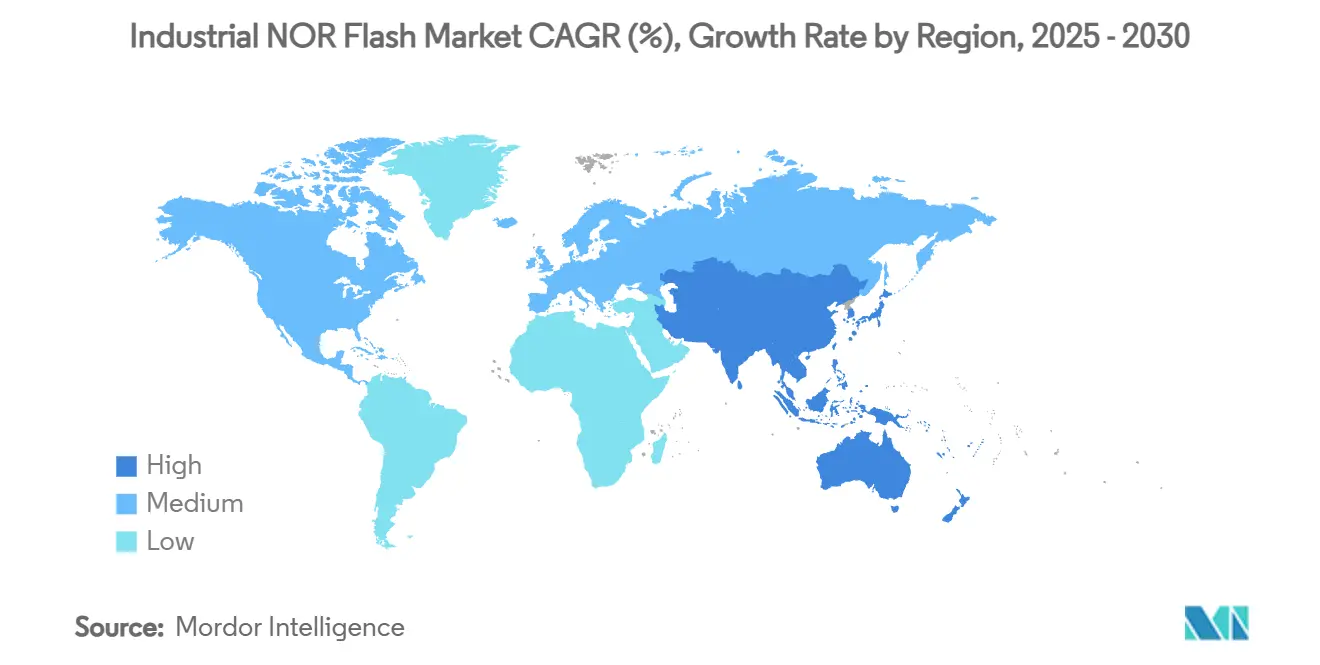
Competitive Landscape
The Industrial NOR flash market displays moderate concentration. Winbond, Macronix, GigaDevice, Infineon, and Micron captured more than 55% of the 2024 revenue. Established vendors compete on endurance, extended-temperature range, and integrated security, such as PQC engines—Winbond released the first PQC-enabled flash in December 2024.
New entrants, mainly from China, scale 55 nm capacity rapidly and undercut pricing, pressuring incumbents’ margins. GigaDevice’s profitability surge underscores this momentum. Hybrid-memory specialists like Everspin push MRAM for FPGA configuration loads, challenging NOR in high-write-cycle niches. Meanwhile, foundry-customer partnerships deepen; OEMs co-develop flash IP on sub-28 nm nodes to embed NOR macro blocks into industrial SoCs, a move that shrinks discrete unit volumes but secures long-term node access.
Strategic moves highlight the evolving field. Infineon launched a 512 Mbit rad-hard QSPI part for satellite fleets, staking leadership in aerospace memory. Macronix’s ArmorBoot MX76 line targets rapid initialization in AI imaging gear, reflecting demand for faster secure boot. onsemi rolled out a 256 Mb serial device spanning 1.8-3.3 V to serve mixed-voltage PLC backplanes. Collectively, suppliers emphasize security features and interface speed over raw density as differentiators in industrial bids.
Industrial NOR Flash Industry Leaders
-
Winbond Electronics Corporation
-
Macronix International Co. Ltd.
-
GigaDevice Semiconductor Inc.
-
Puya Semiconductor (Shanghai) Co. Ltd.
-
Elite Semiconductor Microelectronics Technology Inc.
- *Disclaimer: Major Players sorted in no particular order
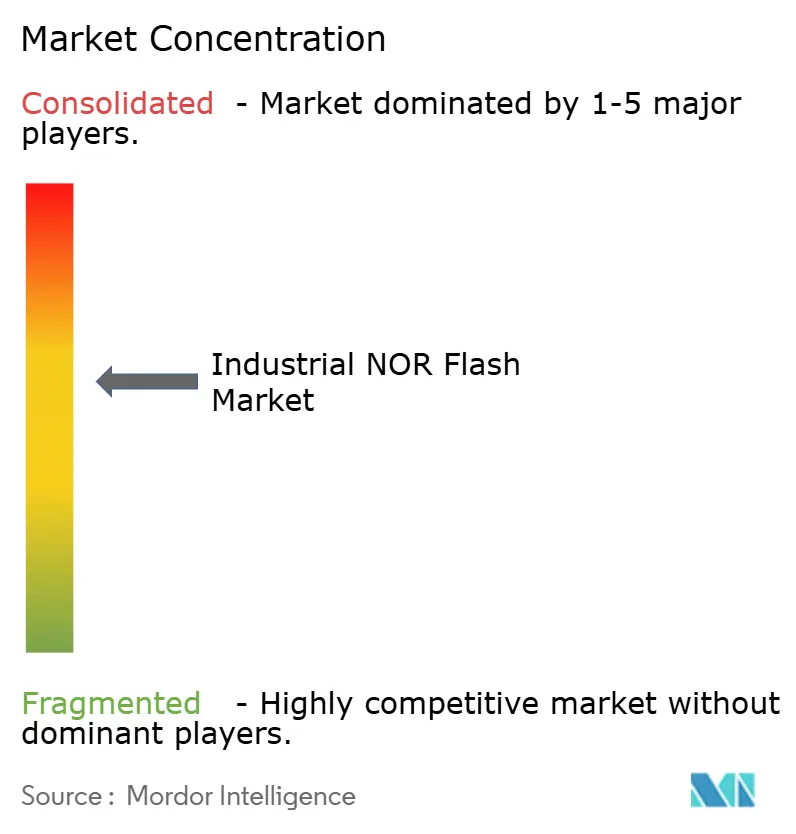
Recent Industry Developments
- May 2025: Bivocom upgraded its TR323/TG453/TG463 5G gateways to 64 MB+ NOR Flash, enabling dual-partition OTA and deeper data logs.
- March 2025: Infineon released a 512 Mbit radiation-hardened QSPI NOR Flash running 133 MHz for LEO satellites.
- February 2025: TSMC reported progress on 2 nm and volume plans for RRAM/MRAM to address future industrial memory nodes.
- December 2024: Winbond debuted the W77T Secure Flash family, ISO26262 ASIL-D ready with 400 MB/s bandwidth and PQC support.
Research Methodology Framework and Report Scope
Market Definitions and Key Coverage
Our study defines the industrial NOR flash memory market as revenue generated from serial and parallel NOR devices that are designed, qualified, and marketed for factory automation, robotics, medical instrumentation, utilities, and other harsh-environment embedded systems where secure, byte-level code execution is vital.
Scope Exclusion: Consumer electronics, telecom handsets, and mainstream automotive infotainment sockets lie outside this industrial focus.
Segmentation Overview
- By Type (Value, Volume)
- Serial NOR Flash
- Parallel NOR Flash
- By Interface (Value)
- SPI Single / Dual
- Quad SPI
- Octal and xSPI
- By Density (Value)
- 2 Megabit And Less NOR
- 4 Megabit And Less-NOR (greater than 2mb) NOR
- 8 Megabit And Less (greater than 4mb) NOR
- 16 Megabit And Less (greater than 8mb) NOR
- 32 Megabit And Less (greater than 16mb) NOR
- 64 Megabit And Less (greater than 32mb) NOR
- 128 Megabit and Less (greater than 64MB) NOR
- 256 Megabit and Less (greater than 128MB) NOR
- Greater than 256 Megabit
- By Voltage (Value)
- 3 V Class
- 1.8 V Class
- Wide-Voltage (1.65 V - 3.6 V)
- Others - 1.2V Class (and similar sub-1.8V) (2.5V, 5V, etc.)
- By Process Technology Node (Value)
- 90 nm and Older
- 65 nm
- 55 nm (incl. 58 nm)
- 45 nm
- 28 nm and Below
- By Packaging Type (Value)
- WLCSP / CSP
- QFN / SOIC
- BGA / FBGA
- Others
- By Geography (Value, Volume)
- North America
- United States
- Canada
- Mexico
- Europe
- Germany
- France
- United Kingdom
- Italy
- Rest of Europe
- Asia-Pacific
- China
- Japan
- South Korea
- Taiwan
- India
- South East Asia
- Rest of Asia-Pacific
- Rest of the World
- North America
Detailed Research Methodology and Data Validation
Primary Research
Mordor analysts spoke with component distributors in Asia, firmware engineers at PLC makers, and procurement managers from North American medical device firms. These conversations verified operating-temperature requirements, refreshed typical NOR content per board, and highlighted regional lead-time shifts that raw desk research could not reveal.
Desk Research
We collected baseline data from publicly available tier-1 sources such as the International Federation of Robotics, OECD industrial production indices, United States Census Bureau electronics trade tables, and WSTS semiconductor shipment statistics, which help us plot regional demand pools. Company 10-Ks, investor decks, and trade-association white papers on Industry 4.0 deployments supplied spend ratios and density splits. To fine-tune supplier shares and average selling prices, we tapped paid databases like D&B Hoovers for company financials and Questel for patent momentum around Quad and Octal SPI designs. The sources listed are illustrative; many additional publications were consulted for validation and clarification.
Market-Sizing & Forecasting
We start with a top-down construct that reconciles industrial electronics output, average NOR attach rates, and ASP trends, which are then cross-checked through sampled supplier roll-ups for sanity. Key variables like the installed base of industrial MCUs, new smart-factory capital outlay, secure-boot regulations, SPI bandwidth roadmaps, and foundry wafer pricing feed the model. Forecasts employ multivariate regression blended with scenario analysis to capture cycle swings in capital spending and macro demand. Gaps in bottom-up estimates are bridged using channel checks before the totals are finalized.
Data Validation & Update Cycle
Outputs pass variance checks against independent datasets, followed by a two-step peer review. We refresh figures each year and issue interim updates when material events, such as fab outages or major standard releases, move the market. A last-minute sweep ensures clients receive the latest view.
Why Mordor's Industrial NOR Flash Baseline Earns Trust
Published estimates often differ because study scope, density brackets, and refresh cadence vary.
Key gap drivers include a) broader inclusion of consumer and automotive demand, b) use of vendor shipment value without industrial filtering, and c) currency and ASP assumptions that lag contract pricing. Our disciplined segmentation and annual update cadence make our 2025 baseline the dependable reference for planners.
Benchmark comparison
| Market Size | Anonymized source | Primary gap driver |
|---|---|---|
| USD 408.61 M (2025) | Mordor Intelligence | - |
| USD 5.27 B (2025) | Global Consultancy A | Combines consumer, telecom, and industrial volumes under one headline value |
| USD 3.25 B (2025) | Industry Association B | Counts automotive-grade NOR alongside industrial, inflating totals |
| USD 2.78 B (2025) | Trade Journal C | Relies on aggregated vendor revenue without density or end-market parsing |
In sum, our model ties every dollar to transparent variables, leverages on-ground intelligence, and updates promptly, so decision-makers can proceed with confidence.
Key Questions Answered in the Report
What is driving the growth of the Industrial NOR Flash market to 2030?
Strong demand for secure-boot chains, rapid firmware recovery, and Industry 4.0 upgrades lifts adoption, producing a 6.49% CAGR and pushing the market toward USD 559.56 million by 2030.
Why are Octal and xSPI interfaces gaining popularity in industrial designs?
They deliver up to 400 MB/s throughput, cut boot times by 70%, and allow embedded security checks without slowing system startup, meeting next-generation controller requirements.
How does process node evolution affect Industrial NOR Flash market size?
Sub-28 nm flash offers faster read speeds and lower standby current; it is the fastest-growing node group at a 3.9% CAGR, expanding the addressable market in high-performance industrial gear.
What regions lead demand for Industrial NOR Flash?
Asia-Pacific holds 55% share and posts the highest 5.9% CAGR due to its large manufacturing base, followed by North America where aerospace and defense specify high-reliability, secure devices.
Page last updated on:



